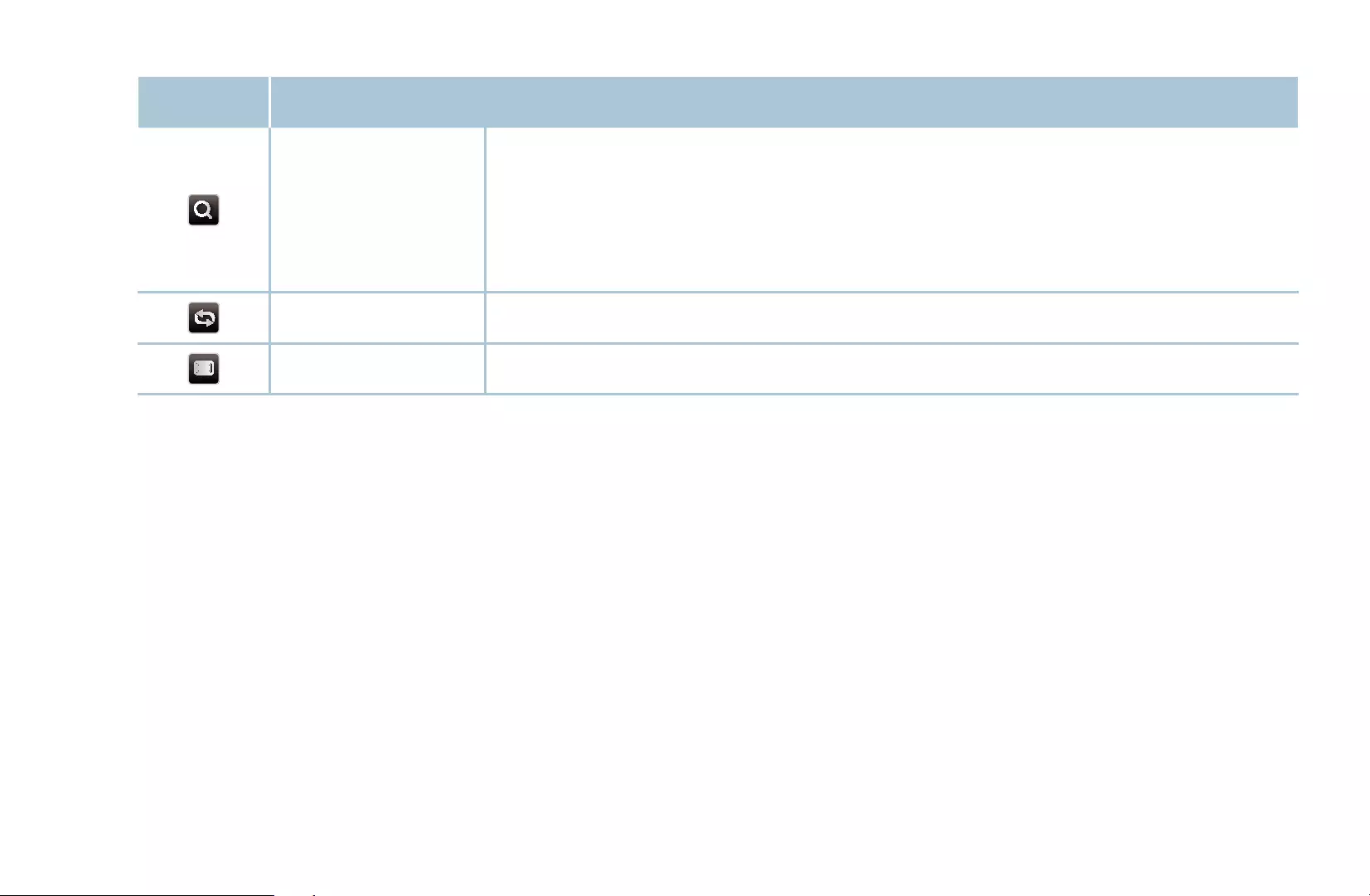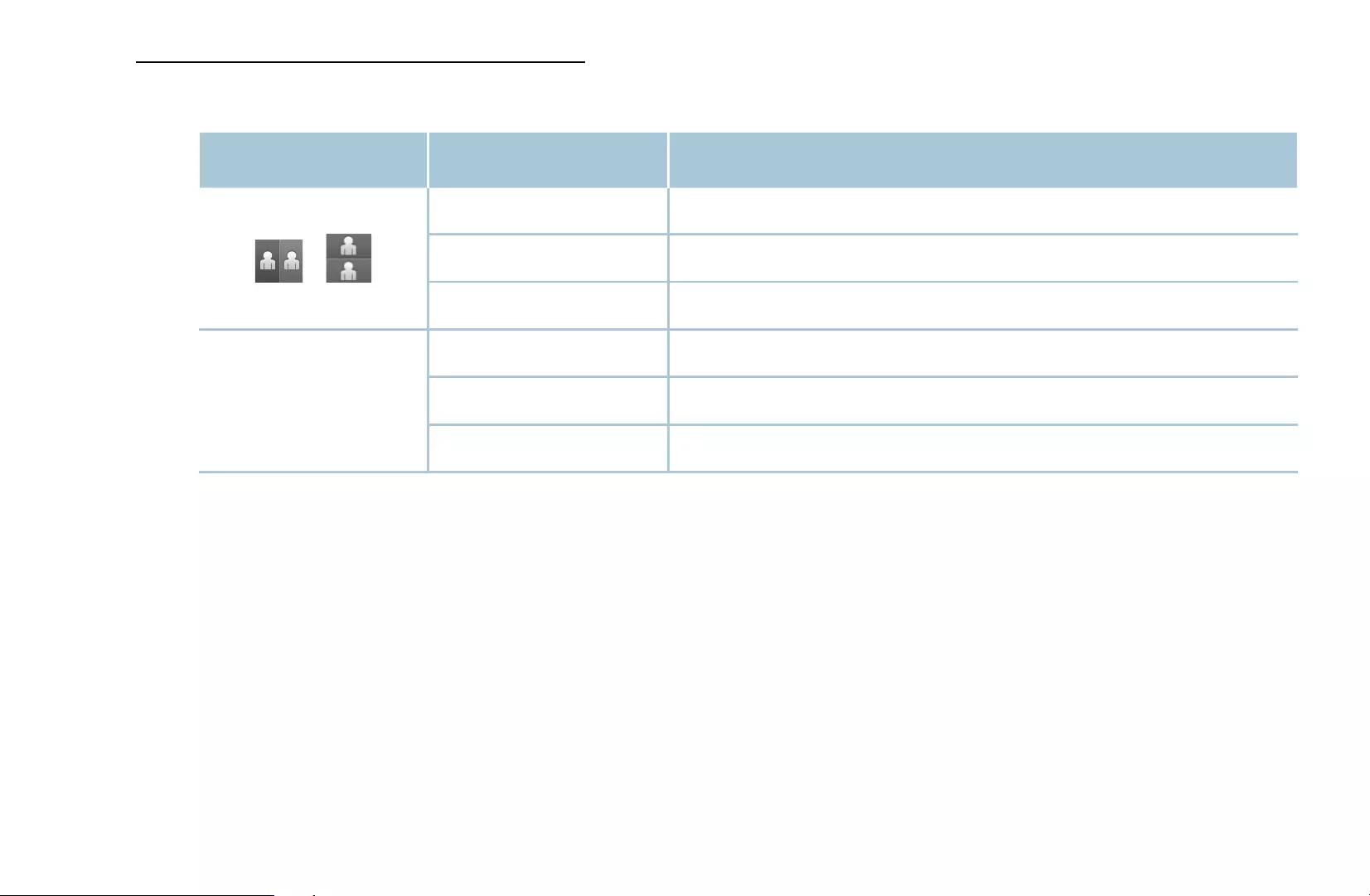Samsung UE32J4100AW User Manual
Displayed below is the user manual for UE32J4100AW by Samsung which is a product in the TVs category. This manual has pages.
Related Manuals

▶
❑Using the INFO button (Now & Next guide)
The display identifies the current channel and the status of certain audio-video
settings.
The Now & Next guide shows daily TV programme information for each channel
according to the broadcasting time.
NWhen you press the INFO button, a channel information banner will appear
on the top of the screen. And then press the ENTERE button, you can see
the details of the programme.
●Scroll ◄, ► to view information for a desired programme while watching
the current channel.
●Scroll ▲, ▼ to view information for other channels.
Channel Setting
English

◀ ▶
❑Memorizing channels
■Aerial
OMENUm → Broadcasting → Aerial → ENTERE
Before your television can begin memorising the available channels, you must
specify the type of signal source that is connected to the TV.
English

◀ ▶
■Auto Tuning
(depending on the country)
OMENUm → Broadcasting → Auto Tuning → ENTERE
NAutomatically allocated programme numbers may not correspond to actual
or desired programme numbers. If a channel is locked, the PIN input window
appears.
●Auto Tuning
Aerial (Air/Cable): Select the aerial source to memorise.
NWhen selecting Air, scans for a channel automatically and stores in the
T V.
Channel Type (Digital & Analogue / Digital / Analogue): Select the channel
source to memorise.
Channel Ordering (depending on the country): Select the channel order type.
English

◀ ▶
When selecting Cable → Digital & Analogue, Digital or Analogue
–Operator Selection (depending on the country): Selects a provider of
cable services.
–Search Mode: Scans for all channels with active broadcast stations and
stores them in the TV.
NIf you select Quick, you can set up the Network, Network ID,
Frequency, Modulation and Symbol Rate manually by pressing the
button on the remote control.
–Network: Selects the Network ID setting mode among Auto or Manual.
●Network ID: When Network is Manual, you can set up Network ID
using the numeric buttons.
English

◀ ▶
●Frequency: Displays the frequency for the channel (differs in each
country).
●Modulation: Displays available modulation values.
●Symbol Rate: Displays available symbol rates.
●Cable Search Option
(depending on the country & cable channels only)
Sets additional search options such as the frequency and symbol rate for a
cable network search.
Start Frequency / Stop Frequency: Set the start or stop frequency (differs in
each country).
Symbol Rate: Displays available symbol rates.
Modulation: Displays available modulation values.
English

◀ ▶
❑Using the Channel menu
OMENUm → Broadcasting → Channel List → ENTERE
■Channel List
The Channel List contains the channels your TV displays when you press the
channel button. You can view channel information, All, TV, Radio, Data/Other,
Analogue or Favourites 1-5.
Press ► (Mode) button to change the channel mode, or press ◄ (Sorting)
button to change the channel order according to channel number or name on the
list.
NWhen you press the CH LIST button on the remote control, Channel List
screen will be displayed at once.
English

◀ ▶
Channel Sorting
●Number / Name: Arranges the channel order according to channel number or
name on the list.
Channel Mode
●Aerial: Switches to Air or Cable.
●Edit Favourites: Set channels you watch frequently as favourites.
NFor detailed information about using Edit Favourites, refer to “Edit
Favourites”.
●Favourites 1-5: Shows all favourite channels, arranged in up to five groups.
Each group has a separate screen.
NThe TV displays Favourites 1-5 only if you have added favourites using
Edit Favourites.
English

◀ ▶
●All: Shows all currently available channels.
●TV: Shows all currently available TV channels.
●Radio: Shows all currently radio channels.
●Data/Other: Shows all currently available MHP or other channels.
●Analogue: Shows all currently available analogue channels.
English

◀ ▶
■Guide
OMENUm → Broadcasting → Guide → ENTERE
The EPG (Electronic Programme Guide) information is provided by broadcasters.
Using programme schedules provided by broadcasters, you can specify
programmes you want to watch in advance so that the channel automatically
changes to the selected programme channel at the specified time. Programme
entries may appear blank or out of date depending on a channel status.
●a Red (Quick Nav): Viewing the TV programmes on the list quickly using
▲/▼/◄/► buttons.
●b Green (Channel Category): Select the type of channels you want to
display.
●{ Yellow (Schedule Manager): Moves to the reserved programmes in
Schedule Manager.
English

◀ ▶
■Schedule Manager
OMENUm → Broadcasting → Schedule Manager → ENTERE
You can set a desired channel to be displayed automatically at the intended time.
In addition, you can view, modify or delete a channel you have reserved to watch.
NYou must set the current time first using the Time → Clock function in the
System menu to use this function.
1. Press the Schedule on the Schedule Manager screen. The Schedule
Viewing menu appears.
2. Press the ▲/▼/◄/► buttons to set each option menu.
●Aerial: Select the desired broadcasting signal.
●Channel: Select the desired channel.
English

◀ ▶
●Repeat: Select Once, Manual, Sat~Sun, Mon~Fri or Everyday to set at
your convenience. If you select Manual, you can set the day you want.
NThe (c) mark indicates the day you’ve selected.
●Date: You can set the desired date.
NIt is available when you select Once in Repeat.
●Start Time: You can set the start time you want.
NIf you want to edit or cancel a reserved schedule, select the reserved
schedule on Schedule Manager. Then press the ENTERE button and
select the Edit or Delete.
English

◀ ▶
■Edit Channel
OMENUm → Broadcasting → Edit Channel → ENTERE
You can edit or delete channels.
1. Go to Edit Channel screen.
2. Press the ▲/▼ buttons to select the desired channel, then press the
ENTERE button. The (c) mark indicates the channel you’ve selected.
NYou can select more than one channel.
NPress the ENTERE again to deselect the channel.
English

◀ ▶
NUsing the coloured and function buttons with the Edit Channel.
●a Red (Change Number): Changes channel order on the channel list.
–E (Done): Completes changing the channel order.
NDigital channel does not support this function when the Edit Channel
Number (depending on the country) is set to Disable.
●b Green (Delete): Deletes a channel from the channel list.
●{ Yellow (Lock / Unlock): Lock a channel so that the channel cannot be
selected and viewed. / Unlock the channel that you locked.
NThis function is available only when the Channel Lock is set to On.
NThe PIN input screen appears. Enter your 4-digit PIN. Change the
PIN using the Change PIN option.
English

◀ ▶
●} Blue (Select All / Deselect All): Selects or deselects all channels at
once.
● (Go To): Goes to channel directly by pressing numbers (0~9).
●k (Page): Moves to previous or next page.
●T (Tools): Displays the option menu. The option menu items that appear
may differ depending on the channel status and type.
–Sorting (digital channels only): Changes the list ordered by channel
number or channel name.
–Aerial: Selects the desired broadcasting signal.
English

◀ ▶
–Category: Change the channel mode to All, TV, Radio, Data/Other,
Analogue, Recently Viewed, Most Viewed. The selected channel
mode is displayed.
–Edit Favourites: Go to Edit Favourites screen directly.
–Rename channel (analogue channels only): Assign a name of up to
five characters to a channel. For example, Food, Golf, etc. This makes
it easier to find and select the channel.
–Channel Info: Display details of the selected channel.
–Information: Display details of the selected programme.
English

◀ ▶
■Edit Favourites t
OMENUm → Broadcasting → Edit Favourites → ENTERE
You can add, edit or delete favourite channels.
1. Go to Edit Favourites screen.
2. Press the ▲/▼ buttons to select the desired channel, and then press
ENTERE button.
3. Choose a specific favourite list among Favourites 1-5 using b (Change Fav.)
button, and then press the } (Add) button. The selected channel has been
added in Favourites 1-5.
NOne favourite channel can be added in several of favourites among
Favourites 1-5.
English

◀ ▶
NUsing the coloured and function buttons with the Edit Favourites.
●a Red (Category / Change order)
–Category: Changes the channel mode to All, TV, Radio, Analogue,
Data/Other, Recently Viewed, Most Viewed. The selected channel
mode is displayed.
–Change order: Changes the favourite channel order.
–E (Done): Completes changing the channel order.
English

◀ ▶
●b Green (Change Fav.): Changes favourite list among Favourites 1-5.
●{ Yellow (Select All / Deselect All): Selects or deselects all channels at
once.
●} Blue (Add / Delete)
–Add: Adds selected channels to Favourites 1-5.
–Delete: Deletes the favourite channel from Favourites 1-5.
English

◀ ▶
● (Go To): Goes to channel directly by pressing numbers (0~9).
●k (Page): Moves to previous or next page.
●T (Tools): Displays the option menu. The option menu items that appear
may differ depending on the channel status and type.
–Copy to Favourites: Edit the selected favourite channel in Favourites
1-5.
–Rename Favourites: Assign your own favourite channel name.
–Aerial: Select the desired broadcasting signal.
–Edit Channel: Go to Edit Channel screen directly.
–Information: Display details of the selected programme.
English

◀ ▶
❑Locking Programme
■Programme Rating Lock
(depending on the country)
OMENUm → Broadcasting → Programme Rating Lock → ENTERE
Prevent unauthorised users, such as children, from watching unsuitable
programme with a user-defined 4-digit PIN code. If the selected channel is
locked, the “\” symbol will be displayed.
NThe items of Programme Rating Lock differs depending on the country.
English

◀ ▶
■Channel Lock
OMENUm → Broadcasting → Channel Lock → ENTERE
Lock channels in Channel menu to prevent unauthorised users, such as children,
from watching unsuitable programme.
NAvailable only when the Source is set to TV.
English

◀ ▶
❑Other Features
■Channel Settings
OMENUm → Broadcasting → Channel Settings → ENTERE
●Country (Area)
(depending on the country)
The PIN input screen appears. Enter your 4 digit PIN number.
Digital Channel: Change the country for digital channels.
Analogue Channel: Change the country for analogue channels.
English

◀ ▶
●Manual Tuning
Scans for a channel manually and stores in the TV.
NIf a channel is locked, the PIN input window appears.
NAccording to the channel source, Manual Tuning may be supported.
●Digital Channel Tuning: Scans for a digital channel manually and stores
in the TV. Press the New button to search the digital channels. When
scanning has finished, a channel is updated in the channel list.
–When selecting Aerial → Air: Channel, Frequency, Bandwidth
–When selecting Aerial → Cable: Frequency, Modulation, Symbol
Rate
English

◀ ▶
●Analogue Channel Tuning: Scans for an analogue channel. Press the
New button to search the channels by adjusting the Programme, Colour
System, Sound System, Channel, Search.
NChannel mode
–P (programme mode): When tuning is complete, the broadcasting
stations in your area have been assigned to the position numbers
from P0 to P99. You can select a channel by entering the position
number in this mode.
–C (aerial channel mode) / S (cable channel mode): These two
modes allow you to select a channel by entering the assigned
number for each aerial broadcasting station or cable channel.
English

◀ ▶
●Fine Tune
(analogue channels only)
If the signal is weak or distorted, fine tune the channel manually.
NFine tuned channels are marked with an asterisk “*”.
NTo reset the fine-tuning, select Reset.
●Transfer Channel List
(depending on the country)
Imports or exports the channel map. You should connect a USB storage to
use this function.
NThe PIN number input screen appears. Enter your 4 digit PIN number.
NSupported file systems are FAT and exFAT.
●Delete CAM Operator Profile: Selects the CAM operator to delete.
English

◀ ▶
■Subtitle t
OMENUm → Broadcasting → Subtitle → ENTERE
Use this menu to set the Subtitle mode.
●Subtitle: Switches subtitles on or off.
●Subtitle Mode: Sets the subtitle mode.
●Subtitle Language: Sets the subtitle language.
NIf the programme you are watching does not support the Hearing
Impaired function, Normal automatically activates even if the Hearing
Impaired mode is selected.
English

◀ ▶
NEnglish is the default in cases where the selected language is unavailable
in the broadcast.
●Primary Subtitle: Sets the primary subtitle.
●Secondary Subtitle: Sets the secondary subtitle.
■Edit Channel Number (depending on the country)
OMENUm → Broadcasting → Edit Channel Number → ENTERE
Use this change channel number. When channel number is changed, channel
information is not updated automatically.
English

◀ ▶
■Audio Options
(digital channels only)
OMENUm → Broadcasting → Audio Options → ENTERE
●Audio Language t
Change the default value for audio languages.
Primary Audio / Secondary Audio: You can set the primary or secondary
audio.
NThe available language may differ depending on the broadcast.
English

◀ ▶
●Audio Format
When sound is emitted from both the main speaker and the audio receiver,
a sound echo may occur due to the decoding speed difference between
the main speaker and the audio receiver. In this case, use the TV Speaker
function.
NAudio Format option may differ depending on the broadcast. 5.1ch
Dolby digital sound is only available when connecting an external speaker
through an optical cable.
●Audio Description (not available in all locations)
This function handles the Audio Stream for the AD (Audio Description) which
is sent along with the Main audio from the broadcaster.
Audio Description: Turn the audio description function on or off.
Volume: Adjust the audio description volume.
English

◀ ▶
■Teletext Language
(depending on the country)
OMENUm → Broadcasting → Teletext Language → ENTERE
●Teletext Language
NEnglish is the default in cases where the selected language is unavailable
in the broadcast.
●Primary teletext / Secondary teletext
NPrimary teletext and Secondary teletext may not be supported in
some locations.
English

◀ ▶
■Digital Text
(UK only)
OMENUm → Broadcasting → Digital Text → ENTERE
If the programme broadcasts with digital text, this feature is enabled.
NMHEG (Multimedia and Hypermedia Information Coding Experts Group)
An International standard for data encoding systems used in multimedia and
hypermedia. This is at a higher level than the MPEG system which includes
data-linking hypermedia such as still images, character service, animation,
graphic and video files as well as multimedia data. MHEG is user runtime
interaction technology and is being applied to various fields including VOD
(Video-On-Demand), ITV (Interactive TV), EC (Electronic Commerce), tele
education, teleconferencing, digital libraries and network games.
English

◀ ▶
■Common Interface
OMENUm → Broadcasting → Common Interface → ENTERE
●CI Menu: This enables the user to select from the CAM-provided menu.
Select the CI Menu based on the menu CI CARD.
●CAM video transcoding: You can configure the setting to transcode the
video codec from the CAM automatically. Turn it Off if you do not want to use
it.
NYou must use a CAM that supports transcoding the video codec.
English

◀ ▶
●Application Info: View information on the CAM inserted into the CI slot and
on the “CI or CI+ CARD” which is inserted into the CAM. You can install the
CAM anytime whether the TV is on or off.
1. Purchase a CI CAM module at your nearest dealer or by phone.
2. Firmly insert the “CI or CI+ CARD” into the CAM in the direction of the
arrow.
3. Insert the CAM with the “CI or CI+ CARD” into the common interface slot,
in the direction of the arrow so that it aligns parallel with the slot.
4. Check if you can see a picture on a scrambled signal channel.
English

◀ ▶
❑Changing the Preset Picture Mode
■Picture Mode t
OMENUm → Picture → Picture Mode → ENTERE
Select your preferred picture type.
NWhen connecting a PC, you can only make changes to the Entertain and
Standard.
●Dynamic: Suitable for a bright room.
●Standard: Suitable for a normal environment.
●Natural for LED 5 series 32" and above : Suitable for reducing eye strain.
●Movie: Suitable for watching movies in a dark room.
●Entertain: Suitable for watching movies and games.
NIt is only available when connecting a PC.
Basic Features
English

◀ ▶
❑Adjusting Picture Settings
■Samsung MagicAngle for LED 19", 22" models
OMENUm → Picture → Samsung MagicAngle → ENTERE
Adjust screen viewing Angle to optimise screen quality according to your viewing
position.
●Samsung MagicAngle: When viewing the screen at an angle from below or
above by setting the appropriate mode for each position, you can obtain a
similar picture quality as viewing the screen directly from the front.
English

◀ ▶
Off: Select when viewing from the front position.
Lean Back Mode: Select when viewing from a slightly lower position.
Standing Mode: Select when viewing from the upper position.
●Mode: Adjust screen viewing angle.
NWhen Samsung MagicAngle is set to Lean Back Mode or Standing Mode,
Gamma is not available.
English

◀ ▶
■Backlight for LED TV / Cell Light for PDP TV / Contrast / Brightness /
Sharpness / Colour / Tint (G/R)
Your television has several setting options for picture quality control.
NNOTE
●In analogue TV, Ext., AV modes of the PAL system, the Tint (G/R)
function is not available.
●When connecting a PC, you can only make changes to
Backlight for LED TV / Cell Light for PDP TV , Contrast, Brightness and
Sharpness.
●Settings can be adjusted and stored for each external device connected
to the TV.
●Lowering picture brightness reduces power consumption.
English

◀ ▶
■Picture Size
OMENUm → Picture → Picture Size → ENTERE
Set the various picture options such as picture size and aspect ratio.
NThe available items may differ depending on the selected mode.
NDepending on the input source, the picture size options may vary.
●Picture Size t: Your cable box/satellite receiver may have its own set
of screen sizes as well. However, we highly recommend you use 16:9 mode
most of the time.
Auto Wide: Automatically adjusts the picture size to the 16:9 aspect ratio.
16:9: Sets the picture to 16:9 wide mode.
English

◀ ▶
Wide Zoom: Magnifies the picture size more than 4:3.
NAdjusts the Position by using ▲, ▼ buttons.
Zoom: Magnifies the 16:9 wide pictures vertically to fit the screen size.
NAdjusts the Zoom or Position by using ▲, ▼ button.
4:3: Sets the picture to basic (4:3) mode.
NDo not watch in 4:3 format for a long time. Traces of borders displayed
on the left, right and centre of the screen may cause image retention
(screen burn) which are not covered by the warranty.
Screen Fit: Displays the full image without any cut-off when HDMI (720p /
1080i / 1080p) or Component (1080i / 1080p) signals are inputted.
English

◀ ▶
●Smart View 1 for LED 5 series 32" and above : Reduces the 16:9 picture by 50%.
●Smart View 2 for LED 5 series 32" and above : Reduces the 16:9 picture by 25%.
NNOTE
●Smart View 1 for LED 5 series 32" and above is enabled only in HDMI
mode.
●Smart View 2 for LED 5 series 32" and above is enabled only in DTV and
HDMI modes.
●The picture size can vary depending on the input resolution when
content is played using Videos under Media Play.
●Zoom/Position: Adjust the picture size and position. It is only available in
Zoom.
●Position: Adjust the picture position. It is only available in Screen Fit or Wide
Zoom.
English

◀ ▶
NNOTE
●After selecting Screen Fit in HDMI (1080i / 1080p) or Component (1080i
/ 1080p) mode, you may need to centre the picture:
1. Select the Position. Press the ENTERE button.
2. Press the ▲, ▼, ◄ or ► button to move the picture.
●If you want to reset the position you adjusted, select Reset in the
Position screen. The picture will be set to its default position.
●If you use the Screen Fit function with HDMI 720p input, 1 line will be cut
at the top, bottom, left and right as in the overscan function.
●4:3 Screen Size: Available only when picture size is set to Auto Wide. You
can determine the desired picture size at the 4:3 WSS (Wide Screen Service)
size or the original size. Each European country requires different picture size.
English

◀ ▶
■PIP t
OMENUm → Picture → PIP → ENTERE
You can watch the TV tuner and one external video source simultaneously. For
example, if you have a cable box connected to the Cable In jack, you can use PIP
to watch programs from the cable box and watch a movie from a Blu-ray player
attached to the HDMI In jack. PIP does not function in the same mode.
NNOTE
●If you turn the TV off while watching in PIP mode, the PIP window will
disappear.
●You may notice that the picture in the PIP window becomes slightly
unnatural when you use the main screen to view a game or karaoke.
English

◀ ▶
●PIP settings
Main picture Sub picture
Component, HDMI, HDMI2/DVI TV
●PIP: Activate or deactivate the PIP function.
●Aerial: Select either Air or Cable as the input source for the sub-screen.
●Channel: Select the channel for the sub-screen.
●Size (õ / ã): Select a size for the sub-picture.
●Position (ã / – / — / œ): Select a position for the sub-picture.
●Sound Select: You can choose the desired sound in PIP mode.
English

◀ ▶
❑Changing the Picture Options
■Advanced Settings
OMENUm → Picture → Advanced Settings → ENTERE
(available in Standard / Movie mode)
You can adjust the detailed setting for the screen including colour and contrast.
NWhen connecting a PC, you can only make changes to the White Balance
and Gamma.
●Dynamic Contrast: Adjust the screen contrast.
●Black Tone: Select the black level to adjust the screen depth.
●Flesh Tone: Adjust the flesh tone colour.
English

◀ ▶
●RGB Only Mode: Displays the Red, Green and Blue colour for making fine
adjustments to the hue and saturation.
●Colour Space: Adjust the range of colours available to create the image.
NTo adjust Colour, Red, Green, Blue and Reset, set Colour Space to
Custom. for PDP TV
●White Balance: You can adjust the colour temperature of the picture to make
white objects look white, and the overall picture appear natural.
2 Point: You can adjust each of the 3 colour's luminosity with the offset menu
and the brightness with the gain menu. To restore the default values, select
Reset.
English

◀ ▶
10 Point for PDP TV : You can adjust the white balance by adjusting the
brightness of each of the 10 sections of red, green, and blue colours of the
input signal. To choose a section, select a desired section in Level field.
NYou can use the 10 Point function only when the Picture Mode is set to
Movie. Some external devices may not support the function.
English

◀ ▶
●Gamma: Adjust the primary colour intensity.
●Motion Lighting: Reduce power consumption by brightness control adapted
motion.
NThis function is not supported in 3D mode. for PDP 4900
NOnly available in Standard mode.
NWhen changing a setting value of Backlight for LED TV / Cell
Light for PDP TV , Brightness or Contrast, Motion Lighting will be set to
Off.
English

◀ ▶
■Picture Options
OMENUm → Picture → Picture Options → ENTERE
NWhen connecting a PC, you can only make changes to the Colour Tone.
●Colour Tone
NWarm1 or Warm2 will be deactivated when the picture mode is
Dynamic.
NSettings can be adjusted and stored for each external device connected
to an input on the TV.
●Digital Clean View: If the broadcast signal received by your TV is weak, you
can activate the Digital Clean View feature to reduce any static and ghosting
that may appear on the screen.
NWhen the signal is weak, try other options until the best picture is
displayed.
English

◀ ▶
Auto Visualisation: When changing analogue channels, displays signal
strength.
NOnly available for analogue channels.
NWhen the INFO button is pressed, the signal strength bar is displayed.
NWhen bar is green, you are receiving the best possible signal.
●MPEG Noise Filter: Reduces MPEG noise to provide improved picture
quality.
●HDMI Black Level: Selects the black level on the screen to adjust the screen
depth.
NAvailable only in HDMI mode (RGB signals).
English

◀ ▶
●Film Mode: Sets the TV to automatically sense and process film signals from
all sources and adjust the picture for optimum quality.
NThe Cinema Smooth function is only activated when HDMI 24Hz signal
is inputted. for PDP TV
NAvailable in TV mode and external input mode which supports SD (480i /
576i) and HD (1080i) except in PC mode.
NIf the screen does not seem natural, change its option to Off / Auto1 /
Auto2 in Film Mode.
English

◀ ▶
●LED Clear Motion for LED TV : Removes drag from fast scenes with a lot of
movement to provide a clear picture.
NIt will be deactivated when the picture mode is set to Natural.
NThe screen may become slightly darker when you play LED Clear
Motion.
●Black Optimiser for PDP TV : Realizes of the black colour deeply and expands
the contrast ratio.
NWhen connecting a PC, it will be set to off and deactivated.
NWhen the TV is operating other applications, it will be deactivated. (ex.
Media Play, PIP, Teletext)
English

◀ ▶
■Picture Off t
OMENUm → Picture → Picture Off → ENTERE
The screen is turned off but the sound remains on. Press any button except
volume button to turn on the screen.
English

◀ ▶
■Reset Picture
OMENUm → Picture → Reset Picture → ENTERE
Resets your current picture mode to its default settings.
English

◀ ▶
❑Changing the Preset Sound Mode
■Sound Mode
OMENUm → Sound → Sound Mode → ENTERE
●Standard: Selects the normal sound mode.
●Music: Emphasises music over voices.
●Movie: Provides the best sound for movies.
●Clear Voice: Emphasises voices over other sounds.
●Amplify: Increase the intensity of high-frequency sound to allow a better
listening experience for the hearing impaired.
NIf Speaker Select is set to External Speaker, Sound Mode is disabled.
English

◀ ▶
❑Adjusting Sound Settings
■Sound Effect
(standard sound mode only)
OMENUm → Sound → Sound Effect → ENTERE
●DTS TruSurround
This function provides a virtual 5.1 channel surround sound experience
through a pair of speakers using HRTF (Head Related Transfer Function)
technology.
●DTS TruDialog
This function allows you to increase the intensity of a voice over background
music or sound effects so that dialogue can be heard more clearly.
English

◀ ▶
●Equaliser
Use Equaliser to customize sound setting for each speaker.
Balance: Adjusts the balance between the right and left speaker.
100Hz / 300Hz / 1kHz / 3kHz / 10kHz (Bandwidth Adjustment): Adjusts the
level of specific bandwidth frequencies.
Reset: Resets the equaliser to its default settings.
NIf Speaker Select is set to External Speaker, Sound Effect is disabled.
English

◀ ▶
■3D Audio for PDP 4900
OMENUm → Sound → 3D Audio → ENTERE
3D audio technology provides the immersive sound corresponding to the pop-up
effect of 3D video by audio depth control in perspective.
NAvailable in only when watching 3D image.
English

◀ ▶
■Speaker Settings
OMENUm → Sound → Speaker Settings → ENTERE
●Speaker Select t
A sound echo may occur due to a difference in decoding speed between
the main speaker and the audio receiver. In this case, set the TV to External
Speaker.
NWhen Speaker Select is set to External Speaker, the volume and
MUTE buttons will not operate and the sound settings will be limited.
English

◀ ▶
NWhen Speaker Select is set to External Speaker.
●TV Speaker: Off, External Speaker: On
NWhen Speaker Select is set to TV Speaker.
●TV Speaker: On, External Speaker: On
NIf there is no video signal, both speakers will be mute.
English

◀ ▶
●Auto Volume
To equalize the volume level on each channel, set to Normal.
Night: This mode provides an improved sound experience compared to
Normal mode, making almost no noise. It is useful at night.
NTo use the volume control on the source device connected to the TV,
set Auto Volume to Off on the TV. Otherwise, a change to the volume
control of the source device may not be applied.
English

◀ ▶
■Additional Settings
OMENUm → Sound → Additional Settings → ENTERE
●DTV Audio Level (digital channels only): This function allows you to reduce
the disparity of a voice signal (which is one of the signals received during a
digital TV broadcast) to a desired level.
NAccording to the type of broadcast signal, MPEG / HE-AAC can be
adjusted between -10dB and 0dB.
NTo increase or decrease the volume, adjust between the range 0 and -10
respectively.
English

◀ ▶
●Digital Audio Out: Digital Audio out is used to provide digital sound, reducing
interference going to speakers and various digital devices such as a DVD
player.
Audio Format: You can select the Digital Audio output format. The available
Digital Audio output format may differ depending on the input source.
NBy connecting to 5.1ch speakers in a Dolby Digital setup, maximize your
interactive 3D sound experience.
Audio Delay: Correct audio-video sync problems, when watching TV or
video, and when listening to digital audio output using an external device such
as an AV receiver (0ms ~ 250ms).
English

◀ ▶
●Dolby Digital Comp: This function minimizes signal disparity between a dolby
digital signal and a voice signal (i.e. MPEG Audio, HE-AAC, ATV Sound).
NSelect Line to obtain dynamic sound, and RF to reduce the difference
between loud and soft sounds at night time.
Line: Set the output level for signals greater or less than -31dB (reference) to
either -20dB or -31dB.
RF: Set the output level for signals greater or less than -20dB (reference) to
either -10dB or -20dB.
■Reset Sound
OMENUm → Sound → Reset Sound → ENTERE
Reset all sound settings to the factory defaults.
English

◀ ▶
Preference Features
❑Selecting the Sound Mode t
When you set to Dual I-II, the current sound mode is displayed on the screen.
Audio Type Dual I-II Default
A2 Stereo
Mono Mono
Automatic change
Stereo Stereo ↔ Mono
Dual Dual I ↔ Dual II Dual I
NICAM Stereo
Mono Mono
Automatic change
Stereo Mono ↔ Stereo
Dual Mono → Dual I
Dual II Dual I
NIf the stereo signal is weak and an automatic switching, occurs, then switch
to the mono.
NOnly activated in stereo sound signal.
NOnly available when the Source is set to TV.
English

◀ ▶
❑Executing initial setup
■Setup
OMENUm → System → Setup → ENTERE
Configure the channels and the time when setting up the TV for the first time or
when resetting the unit.
NExecute the initial setup following instructions that the TV guides.
English

◀ ▶
❑Setting the Time
■Time
OMENUm → System → Time → ENTERE
The current time will appear every time you press the INFO button.
●Clock: Setting the clock is for using various timer features of the TV.
NIf you disconnect the power cord, you have to set the clock again.
Clock Mode: Set up the current time manually or automatically.
–Auto: Set the current time automatically using the time from a digital
channel.
English

◀ ▶
NThe aerial must be connected in order to set the time automatically.
–Manual: Set the current time manually.
NDepending on the broadcast station and signal, the auto time set up may
not be correct. In this case, set the time manually.
English

◀ ▶
Clock Set: Set the Date and Time.
NAvailable only when Clock Mode is set to Manual.
NYou can set the Date and Time directly by pressing the number buttons
on the remote control.
Time Zone (depending on the country): Select your time zone.
NThis function is only available when the Clock Mode is set to Auto.
NWhen selecting Manual in Time Zone, GMT and DST will be activated.
English

◀ ▶
Time Offset (depending on the country): Adjusts the time when your TV
receives the time information via Internet. Set the right time by selecting an
offset.
NThe current time will be set through a network, if the TV fails to receive
the time information including the broadcast signal from TV stations. (ex:
Watching TV via set-top box, Satellite receiver, or etc)
English

◀ ▶
❑Using the Sleep Timer
OMENUm → System → Time → Sleep Timer → ENTERE
●Sleep Timer t: Automatically shuts off the TV after a preset period of
time. (30, 60, 90, 120, 150 and 180 minutes)
NUse the ▲/▼ buttons to select a period of time, and then press
ENTERE. To cancel the Sleep Timer, select Off.
English

◀ ▶
❑Setting the On / Off Timer
OMENUm → System → Time → On Timer <or> Off Timer → ENTERE
●On Timer: You can set up three separate On Timer configurations. (On Timer
1, On Timer 2, On Timer 3)
Setup: Select Off, Once, Everyday, Mon~Fri, Mon~Sat, Sat~Sun or
Manual to set at your convenience. If you select Manual, you can set up the
day you want to activate the timer.
NThe c mark indicates the day you’ve selected.
Time: Set the hour and minute.
Volume: Set the desired volume level.
English

◀ ▶
Source: To select the source of the content that will play when the TV turns
on. You can:
–Select TV and have the TV display a specific air or cable channel.
–Select USB and have the TV play back photo or audio files from a USB
device.
–Select a source on your TV (HDMI1, HDMI2/DVI, AV, Component, etc.)
that you have connected a set-top box to, and have the TV display a
channel from the set-top box.
NThe USB device must be connected to your TV before you can select
USB.
English

◀ ▶
NIf you select a source other than TV or USB, you must:
●Have a cable or satellite set-top box attached to that source
●Set the set-top box to the channel you want to watch when the TV
goes on
●Leave the set-top box turned on.
NWhen you select a source other than TV or USB, the Aerial and Channel
options will disappear.
Aerial (when the Source is set to TV): Select ATV or DTV.
Channel (when the Source is set to TV): Select the desired channel.
English

◀ ▶
Music / Photo (when the Source is set to USB): Select a folder in the USB
device containing music or photo files to be played when the TV is turned on
automatically.
–If there is no music file on the USB device or the folder containing a music
file is not selected, the timer function does not operate correctly.
–When there is only one photo file in the USB device, the slide show will not
play.
–If a folder name is too long, the folder cannot be selected.
–Each USB you use is assigned its own folder. When using more than one
of the same type of USB, make sure the folders assigned to each USB
have different names.
English

◀ ▶
–It is recommended that you use a USB memory stick and a multi card
reader when using On Timer.
–The On Timer function may not work with USB devices with a built-in
battery, MP3 players, or PMPs made by some manufacturers because
these devices take a long time to be recognised.
●Off Timer: You can set up three separate Off Timer configurations. (Off Timer
1, Off Timer 2, Off Timer 3)
Setup: Select Off, Once, Everyday, Mon~Fri, Mon~Sat, Sat~Sun or
Manual to set at your convenience. If you select Manual, you can set up the
day you want to activate the timer.
NThe c mark indicates the day you’ve selected.
Time: Set the hour and minute.
English

◀ ▶
❑Economical Solutions
■Eco Solution
OMENUm → System → Eco Solution → ENTERE
●Energy Saving: This adjusts the brightness of the TV in order to reduce
power consumption.
●Eco Sensor for PDP TV / LED 5 series 32" and above : To enhance your power
savings; the picture settings will automatically adapt to the light in the room.
NIf you adjust the Backlight for LED TV / Cell Light for PDP TV , the Eco
Sensor will be set to Off.
English

◀ ▶
Min. Backlight for LED TV / Min Cell Light for PDP TV : When Eco Sensor is
On, the minimum screen brightness can be adjusted manually.
NIf Eco Sensor is On, the display brightness may change (become slightly
darker or brighter) depending on the surrounding light intensity.
●No Signal Power Off: To avoid unnecessary energy consumption, set how
long you want the TV to remain on if it’s not receiving a signal.
NDisabled when the PC is in power saving mode.
●Auto Power Off: If the TV remains turned on for four hours without any user
input, the TV will automatically turn off to prevent overheating.
NIn some areas, you can establish a period of up to 8 hours.
English

◀ ▶
❑Other Features
■Menu Language
OMENUm → System → Menu Language → ENTERE
Set the menu language.
English

◀ ▶◀ ▶
■Auto Protection Time for LED TV
OMENUm → System → Auto Protection Time → ENTERE
●Auto Protection Time (Off / 2 hours / 4 hours / 8 hours / 10 hours):
If the screen remains idle with a still image for a certain period of time defined by
the user, the screen saver is activated to prevent the formation of ghost images
on the screen.
English

◀ ▶
■Screen Burn Protection for PDP TV
OMENUm → System → Screen Burn Protection → ENTERE
To reduce the possibility of screen burn, this unit is equipped with Pixel Shift
screen burn prevention technology. Pixel Shift moves the picture slightly on the
screen. The Time function setting allows you to programme the time between
movement of the picture in minutes.
Your TV also has the following additional screen burn protection functions:
●Pixel Shift
●Auto Protection Time
●Scrolling
●Side Grey
English

◀ ▶
●Pixel Shift: Using this function, you can set the TV to move pixels minutely on
the PDP screen in a horizontal or vertical direction to minimize after images on
the screen.
NAvailable Pixel Shift Settings and Optimum Settings
Item TV / HDMI
Horizontal 0~4 4
Vertical 0~4 4
Time (minute) 1~4 min 4 min
NThe Pixel Shift value may differ depending on the monitor size (inches)
and mode.
NThis function is not available in the Screen Fit mode.
●Auto Protection Time: If the screen displays a still image for a certain period
of time you define, the TV activates the screen saver to prevent the formation
of burnt in ghost images on the screen.
English

◀ ▶
●Scrolling: This function removes after-images on the screen by illuminating all
the pixels on the PDP according to a pattern. Use this function when there are
after images or symbols on the screen, especially when you displayed a still
image on the screen for a long time.
NThe after-image removal function has to be executed for a long time
(approximately 1 hour) to effectively remove after-images on the screen.
If the after-image is not removed after you apply the function, repeat the
function again.
NPress any key on the remote control to cancel this feature.
●Side Grey: When you watch TV with the screen ratio set to 4:3, using the
Side Grey function can prevent damage to the edges of the screen by
adjusting the white balance on the extreme left and right sides.
English

◀ ▶
■General
OMENUm → System → General → ENTERE
●Game Mode: When connecting to a game console such as PlayStation™ or
Xbox™, you can enjoy a more realistic gaming experience by selecting game
mode.
NNOTE
●Precautions and limitations for game mode
–To disconnect the game console and connect another external
device, set Game Mode to Off in the setup menu.
–If you display the TV menu in Game Mode, the screen shakes
slightly.
English

◀ ▶
●Game Mode is not available in TV mode.
●After connecting the game console, set Game Mode to On.
Unfortunately, you may notice reduced picture quality.
●If Game Mode is On:
–Picture Mode is set to Standard and Sound Mode is set to
Movie.
●Panel Lock: Lock or unlock all the keys on the panel at once. when Panel
Lock is on, none of the keys on the panel will work.
●Boot Logo: Display Samsung logo when the TV is turned on.
English

◀ ▶
Advanced Features
■Change PIN
OMENUm → System → Change PIN → ENTERE
Change your password required to set up the TV.
NThe PIN input screen appears before the setup screen.
NEnter your 4-digit PIN. Change the PIN using the Change PIN option.
English

◀ ▶
■DivX® Video On Demand
OMENUm → System → DivX® Video On Demand → ENTERE
Shows the registration code authorised for the TV. If you connect to the DivX
web site and register with 10-digit registration code, you can download the VOD
activation file.
Once you play it using Videos, the registration is completed.
NFor more information on DivX® VOD, visit http://vod.divx.com.
English

◀ ▶
❑Using the Source List
■Source List
OMENUm → Applications → Source List → ENTERE
NWhen you press the SOURCE button, Source screen will be displayed at
once.
NYou can only choose external devices that are connected to the TV. In
Source, connected inputs are highlighted.
NFor the detailed information, refer to “Changing the Input Source” in User
Manual.
English

◀ ▶
❑Connecting a USB Device
1. Turn on your TV.
2. Connect a USB device containing photo, music and movie files to the USB
port on the side of the TV.
3. When USB is connected to the TV, popup window appears. You can select
the Photos, Videos or Music directly.
English

◀ ▶
NIt might not work properly with unlicenced multimedia files.
NNeed-to-Know List before using Media Contents
●MTP (Media Transfer Protocol) is not supported.
●Supported file systems are FAT and exFAT.
●Certain types of USB Digital camera and audio devices may not be
compatible with this TV.
●Media Play only supports sequential jpeg format.
●Media Play only supports USB Mass Storage Class (MSC) devices. MSC
is a Mass Storage Class Bulk-Only Transport device. Examples of MSC
are Thumb drives, Flash Card Readers (USB HUB are not supported).
Devices should be connected directly to the TV’s USB port.
English

◀ ▶
●Before connecting your device to the TV, please back up your files to
prevent them from damage or loss of data. SAMSUNG is not responsible
for any data file damage or data loss.
●Do not disconnect the USB device while it is loading.
●The higher the resolution of the image, the longer it takes to display on
the screen.
●The maximum supported JPEG resolution is 15360 x 8640 pixels.
●For unsupported or corrupted files, the “Not Supported File Format”
message is displayed.
●The scene search and thumbnail functions are not supported in the
Videos.
English

◀ ▶
●MP3 files with DRM that have been downloaded from a non-free site
cannot be played. Digital Rights Management (DRM) is a technology that
supports the creation, distribution and management of the content in an
integrated and comprehensive way, including the protection of the rights
and interests of the content providers, the prevention of the illegal copying
of contents, as well as managing billings and settlements.
●A USB device that requires high power (more than 500mA or 5V) may
not be supported. The HDD (Hard Disk Drive) connected to USB is not
supported.
●If the TV has been no input during time set in Auto Protection Time, the
screen saver will run.
●The power-saving mode of some external hard disk drives may be
released automatically when connected to the TV.
English

◀ ▶
●If a USB extension cable is used, the USB device may not be recognised
or the files on the device may not be read.
●If a USB device connected to the TV is not recognised, the list of files on
the device is corrupted or a file in the list is not played, connect the USB
device to the PC, format the device and check the connection.
●If a file deleted from the PC is still found when Media Contents is run, use
the “Empty the Recycle Bin” function on the PC to permanently delete the
file.
●If the number of files and folders saved on a USB storage device is
approximately over 4000, the files and folders may not appear and some
folders may not be opened.
English

◀ ▶
Disconnecting a USB Device
1. Press the SOURCE button.
2. Select a desired USB device, and then press the TOOLS button. The Tools
menu appears.
3. Select Disconnect USB Device, and then wait until the selected USB device
is disconnected. You can remove a USB device from the TV.
NTo remove a USB device from the TV, we recommend use Disconnect USB
Device function.
English

◀ ▶
❑Using the Media Contents
OMENUm → Applications → Media Play → ENTERE
Enjoy photos, music and movie files saved on a USB Mass Storage Class (MSC)
device.
1. Press the MEDIA.P button.
2. Press
◄/► button to select desired menu (Photos, Videos, Music), then
press the ENTERE button.
3. Press
◄/► button to select desired device, then press the ENTERE button
again.
4. Press the ▲/▼/◄/► button to select the desired file in the list, then press the
ENTERE button or ∂ (Play) button.
English

◀ ▶
Playing the selected files
1. Press the ▲ button to select Options at the top of each main screen and
select Play Selected.
2. Select the desired files.
NThe check box appears to the left of the selected files.
NPress ENTERE button again to deselect the file.
3. Press the ▲ button to select Play.
NYou can select or deselect all files pressing the Select All / Deselect All.
English

◀ ▶
❑Playing the Photos / Videos / Music
During playing a file, press the ▲/▼/◄/► button to select the desired menu.
NWhen the option menu is not displayed, press the TOOLS button or
ENTERE button.
NYou can also use ∂/∑/∫/π/µ buttons on the remote control during
playback.
NIf you press the INFO button during playback, you can view the playback
information.
English

◀ ▶
Playback menu
Button Operation Photos Videos Music
/ Previous / Next ●
/
Start Slide Show / Stop Slide Show ●
Play / Pause Mini Player* ● ●
/ Previous / Next Mini Player* ● ●
/ Rewind / Fast Forward ● ●
* When setting the Background Music to Mini Player in Photos, these buttons previous appear.
English

◀ ▶
Setting menu
● Photos
Button Operation
Slideshow Settings You can set the Speed and Effects during the slide show.
Zoom You can zoom the image.
Rotate You can rotate images in full screen mode.
Background Music /
Mini Player
You can set background music when watching a slide show. /
You can control simple playback menus.
Settings Picture Mode / Sound Mode: You can adjust the picture or
sound setting.
Information: You can see detailed information about the played
file.
English

◀ ▶
NDuring the slide show, all files in the file list will be displayed in order.
NWhen you press the ∂ (Play) button (or ▲ button → Options → Slide
Show) in the file list, slide show will be started immediately.
NDuring the slide show, you can adjust the slide show speed using π (REW)
or µ (FF) button.
●Supported Photo Formats
NFor the details, refer to “Specifications” in User Manual.
English

◀ ▶
● Videos
Button Operation
Search Search Titles: You can move the other file directly.
Search Time Bar: You can search the video using ◄ and ► button
at one minute interval or entering the number directly.
N It may not be supported depending on the input source.
Repeat Mode You can play movie files repeatedly.
Picture Size You can adjust the picture size to your preference.
English

◀ ▶
Button Operation
Settings Subtitle Settings: You can play the video with subtitles. This function
only works if the subtitles are the same file name as the video.
Picture Mode / Sound Mode: You can adjust the picture or sound
setting.
Audio Language: You can change the audio language if the video
has more than one language.
Information: You can see detailed information about the played file.
English

◀ ▶
NIf video time information is unknown, play time and progress bar are not
displayed.
NIn this mode, you can enjoy movie clips contained on a Game, but you
cannot play the Game itself.
●Supported Subtitle / Video Formats
NFor the details, refer to “Specifications” in User Manual.
English

◀ ▶
● Music
Button Operation
Repeat You can play music files repeatedly.
Shuffle You can play the music randomly.
Sound Mode You can adjust the sound setting.
N Only displays the files with supported music file extension. Other file
extensions are not displayed, even if they are saved on the same USB device.
N If the sound is abnormal when playing music files, adjust the Equaliser in the
Sound menu. (An over-modulated music file may cause a sound problem.)
● Supported Music Formats
N For the details, refer to “Specifications” in User Manual.
English

◀ ▶
Setting the Encoding language
Set the encoding language if the text is not supported.
1. Press the ▲ button to select Options at the top of music main screen and
select Encoding.
2. Select the desired encoding language.
English

◀ ▶
❑Using the 3D function
for PDP 4900
Viewing TV using the 3D function
IMPORTANT HEALTH AND SAFETY INFORMATION FOR 3D PICTURES.
Read and understand the following safety information before using the TV’s 3D
function.
[WARNING
●Some viewers may experience discomfort while viewing 3D TV such as
dizziness, nausea and headaches. If you experience any such symptom,
stop viewing 3D TV, remove 3D Active Glasses and rest.
●Watching 3D images for an extended period of time may cause eye
strain. If you feel eye strain, stop viewing 3D TV, remove your 3D Active
Glasses and rest.
English

◀ ▶
●A responsible adult should frequently check on children who are using the
3D function. If there are any reports of tired eyes, headaches, dizziness,
or nausea, have the child stop viewing 3D TV and rest.
●Do not use the 3D Active Glasses for other purposes (such as general
eyeglasses, sunglasses, protective goggles, etc.)
●Do not use the 3D function or 3D Active Glasses while walking or moving
around. Using the 3D function or 3D Active Glasses while moving around
may result in injuries due to running into objects, tripping, and/or falling.
Before using 3D function...
●3D Active Glasses from Samsung’s previous product (IR type) or other
manufacturers not be supported.
●When the TV is initially powered on, may take some time until the 3D display
is optimised.
English

◀ ▶
●The 3D Active Glasses may not work properly if there is any other 3D product
or electronic devices turned on near the glasses or TV. If there is a problem,
keep other electronic devices as far away as possible from the 3D Active
Glasses.
●Be sure to stay within the viewing angle and optimum TV viewing distance
when watching 3D pictures. Otherwise, you may not be able to enjoy proper
3D effects.
●The ideal viewing distance should be three times or more the height of the
screen. We recommend sitting with viewer’s eyes on a level with the screen.
●If you can not play 3D videos in some of the BD players, take out the disk
from player and put it again, or restart the BD player.
English

◀ ▶
■3D
OMENUm → Picture → 3D → ENTERE
This exciting new feature enables you to view 3D content.
N"Full HD 3D Glasses™" Logo indicates compatibility between display
products and 3D Glasses which are compliant with the "Full HD 3D
Glasses™" format, and does not indicate picture quality of display products.
NSome 3D modes may not be available depending on the format of the image
source.
NWhen you watch 3D images under flickering lighting such as a fluorescent
lamp (50Hz ~ 60Hz) or a 3 wavelength lamp, you may notice some screen
flickering. If this occurs, dim or turn off the light.
English

◀ ▶
●3D Mode
If you want to feel the 3D effect fully, please wear the 3D Active Glasses
first, and then select 3D Mode from the list below that provides the best 3D
viewing experience.
3D Mode Operation
Off
Off
Off Turns the 3D function off.
2D → 3D Changes a 2D image to 3D.
NSome file format may not be supported.
Side by Side Displays two images next to each other.
Top & Bottom Displays one image above another.
N3D Mode is set to Off automatically when you access Media Play or
e-Manual functions.
N3D Mode is set to memorised configuration value automatically, when
changing the input source.
English

◀ ▶
●3D Perspective: Adjust overall 3D perspective of on-screen image.
●Depth: Adjust overall depth.
●L/R Change: Swap the left and right pictures.
●3D → 2D: Displays the image for the left eye only.
NThis function is deactivated when 3D Mode set to “ ” or “
Off
Off
”.
English

◀ ▶
Support resolution (16:9 only)
●HDMI
Source Resolution Frequency (Hz)
/
1280 x 720p 50 / 59.94 / 60 Hz
1920 x 1080i 50 / 59.94 / 60 Hz
1920 x 1080p 23.98 / 24 / 25 / 29.97 / 30 / 50 / 59.94 / 60 Hz
Frame Packing
1280 x 720p 50 / 59.94 / 60 Hz
1920 x 1080i 50 / 59.94 / 60 Hz
1920 x 1080p 23.98 / 24 / 25 / 29.97 / 30 Hz
Other Features
English

◀ ▶
●Components & DTV
Source Resolution Frequency (Hz)
Components
1280 x 720p 50 / 59.94 / 60 Hz
1920 x 1080i 50 / 59.94 / 60 Hz
1920 x 1080p 23.98 / 24 / 25 / 29.97 / 30 / 50 / 59.94 / 60 Hz
DTV
1280 x 720p 50 / 59.94 / 60 Hz
1920 x 1080i 50 / 59.94 / 60 Hz
1920 x 1080p 25 Hz
●Videos / Photos (In Media Play)
For the details, refer to “Specifications” in User Manual.
English

◀ ▶
❑Viewing the e-Manual
■e-Manual
OMENUm → Support → e-Manual → ENTERE
You can read the introduction and instructions about the TV features stored in
your TV.
NFor the detailed information about e-Manual Screen, refer to “How to use the
e-Manual” in User Manual.
English

◀ ▶
❑Using the Self Diagnosis
■Self Diagnosis
OMENUm → Support → Self Diagnosis → ENTERE
NSelf Diagnosis might take few seconds, this is part of the normal operation
of the TV.
●Picture Test: Use to check for picture problems.
●3D Picture Test for PDP 4900 series : Use to check for 3D picture problems.
●Sound Test: Use the built-in melody sound to check for sound problems.
NIf you hear no sound from the TV’s speakers, before performing the
sound test, make sure Speaker Select is set to TV Speaker in the
Sound menu.
English

◀ ▶
NThe melody will be heard during the test even if Speaker Select is set to
External Speaker or the sound is muted by pressing the MUTE button.
●Signal Information (digital channels only): HDTV channel’s reception quality
is either perfect or the channels are unavailable. Adjust your aerial to increase
signal strength.
●Reset: Reset all settings to the factory defaults except network settings.
NThe PIN input screen appears before the setup screen.
NEnter your 4-digit PIN. Change the PIN using the Change PIN option.
English

◀ ▶
❑Updating the Software
■Software Update
OMENUm → Support → Software Update → ENTERE
The Software Update menu lets you upgrade your TV’s software to the latest
version.
NWhen software is upgraded, video and audio settings you have made will
return to their default settings. We advise you to write down your settings so
that you can easily reset them after the upgrade.
English

◀ ▶
●Update now
The TV's firmware can be updated through either USB connection or
broadcast signal.
–By USB: Insert a USB drive containing the firmware upgrade file,
downloaded from “www.samsung.com” into the TV.
NPlease be careful not to disconnect the power or remove the USB
drive until upgrades are complete. The TV will be turned off and on
automatically after completing the firmware upgrade.
English

◀ ▶
–By Channel: Upgrade the software using the broadcasting signal.
NIf the function is selected during the software transmission period,
software will be automatically searched and downloaded.
NThe time required to download the software is determined by the
signal status.
●Auto update: This option upgrades the TV while it is in Standby Mode. This
allows the TV to upgrade itself automatically while it is not in use. Because
the TV’s internal processes are operating, the screen may emit a faint glow,
and this may continue for more than 1 hour until the software download is
complete.
●Manage Satellite Channels for LED 5070 / 5270 / 4270 series
(When the Aerial was set to Satellite) Manage software downloads via a
satellite channel.
English

◀ ▶
❑Changing the Use Mode
■Use Mode
OMENUm → Support → Use Mode → ENTERE
Select the Use Mode suitable for your place. We strongly recommend you select
Home Use.
●Home Use: Home Use is the default setting.
●Store Demo: Store Demo is for retail environments only. If you select Store
Demo, some functions will not work, and the picture settings will be reset
every 30 minutes.
English

◀ ▶
❑Viewing the Contact Samsung
■Contact Samsung
OMENUm → Support → Contact Samsung → ENTERE
View this information when your TV does not work properly or when you want to
upgrade the software. You can find information regarding our call centres, and
how to download products and software.
English

◀ ▶
❑Using the Football Mode
■Football Mode t
OMENUm → Applications → Football Mode → ENTERE
This mode provides optimised condition for watching sports games.
●a (Zoom): Pause playback and divide the picture into 9 parts. Select a part
to zoom it in. Press this button again to resume.
NWhen the Football Mode is on, the picture and sound modes are set to
Stadium automatically.
NIf you turn the TV off while watching Football Mode, the Football Mode will
be disable.
NWhen the Data Service is running, the Zoom is not available.
English

◀ ▶
❑Using the Satellite System
for LED 5070 / 5270 / 4270 series
NFor the details, you can find an additional web manual on our website "www.
samsung.com".
English

◀ ▶
❑Using the Wireless Network
for LED 5000 series (UK only) / for PDP 4900 series
NFor the details, you can find an additional web manual on our website "www.
samsung.com".
English

◀ ▶
❑Managing the Network Connected Devices
for PDP 4900 series
NFor the details, you can find an additional web manual on our website "www.
samsung.com".
English

◀
❑Using the DLNA Functions
for PDP 4900 series
NFor the details, you can find an additional web manual on our website "www.
samsung.com".
English